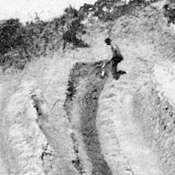Praya East Reclamation Project
| Praya East Reclamation Project | |||||||||||||||||||||
|---|---|---|---|---|---|---|---|---|---|---|---|---|---|---|---|---|---|---|---|---|---|
| Gauge : | 600 mm and 1067 mm | ||||||||||||||||||||
|
|||||||||||||||||||||
In the Praya East Reclamation Project for land reclamation in Hong Kong , Sang Lee & Co. operated two light railways with gauges of 600 mm and 1067 mm (3½ feet) around 1921–1929 .
history
On Hong Kong Island , the old Praya East coastline ran along today's Johnston Road ( s ) until 1921 . In 1921, Sang Lee & Co., whose bid was the lowest at HK $ 2,397,323 , was awarded the contract for the earthmoving work needed to reclaim the land. The land reclamation project, named after the old coastline, lasted from November 1, 1921 to May 31, 1929.
Hand-operated Decauville railway with 600 mm gauge
In the 1920s, a hand-operated Decauville railway was laid on Heard Street in Hong Kong for the Praya East Reclamation Project to move sand, earth and rock from the quarry on Morrison Hill ( en ) to the coastal land reclamation project. The building contractor commissioned by the colonial administration, the company Sang Lee & Co., used easy-to-lay flying track made in France and 50 Decauville tipping lorries.
Steam locomotive-powered narrow-gauge railway with a gauge of 1067 mm
In the 1920s, a narrow gauge steam railway was laid along the Bowrington Canal in Hong Kong for the Praya East Reclamation Project to move rock from the quarry on Morrison Hill ( en ) to the coastal reclamation project. The company Sang Lee & Co. acquired four steam locomotives for this purpose, 1.6 km of narrow-gauge track weighing 17.5 kg / m (35 lbs / yard) and 3.2 km of medium-heavy track weighing 15 kg per meter / m (30 lbs / yard) and 1.6 km of light track at 6 kg / m (12 lbs / yard). It also procured kits with axle housings for one hundred wooden side tippers, each with a loading volume of 0.09 m³ (3¼ cubic feet).
The double-track steam train running along the Bowrington Canal was put into operation in July 1922, after which the transport with the wooden side tippers began. By the end of 1922, 11,610 m³ (410,000 cubic feet) of rock had been transported. In addition to the line on the Bowrington Canal, a narrow-gauge track with 1067 mm gauge was laid on Heard Street, whereupon, from March 1923, wooden side tippers pulled by locomotives were also used there.
In the quarry, the rock was loosened at the top of a channel by a construction worker with a hoe, and then stored above the rocks with boards until it could slide over a board into the wagons. After the contractor had worked for about a year and a half, large quantities of boulders appeared in cut surfaces of the quarry. The removal of these boulders not only significantly increased the cost of acquiring filler material, but also slowed the progress of land reclamation to such an extent that the contractor had to work late into the night to keep up with the progress of the work on the contract time keep constant. Conditions deteriorated increasingly so that the contractor reported in March 1924 that he could not do the work at his contract price of HK $ 0.23 . The colonial administration eventually paid a 76% surcharge to allow the contractor to complete the work.
Land reclamation
The area gained through land reclamation developed cumulatively as follows:
| year | Hectares | Acres | percent |
|---|---|---|---|
| 1924 | 14.6 ha | 36 acres | 40% |
| 1925 | 17.8 ha | 44 acres | 49% |
| 1926 | 23.7 ha | 58.5 acres | 65% |
| 1927 | 30.3 ha | 75 acres | 83% |
| 1928 | 35.2 ha | 87 acres | 97% |
| 1929 | 36.4 ha | 90 acres | 100% |
Individual evidence
- ↑ a b c d e David Bell: c.1928 Praya East Reclamation.
- ↑ a b David Bell: 1920s Excavation of Morrison Hill.
- ↑ David Bell: Photo 25: Goodbye Morrison Hill In: Old Hong Kong Photos and The Tales They Tell, Volume 2. ISBN 9789887827610 .
- ^ A b David Bell: 1920s Bowrington Canal.
- ^ SW Poon and KY Ma: The History of Quarrying in Hong Kong, 1840–1940.
- ↑ David Bell probably inadvertently writes 77.5 kg / m (155 lbs / yard).
Coordinates: 22 ° 16 ′ 45.9 ″ N , 114 ° 10 ′ 52.4 ″ E






